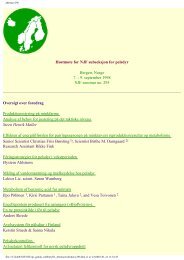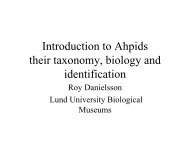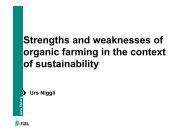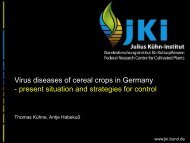Wheat Dwarf Virus in - NJF
Wheat Dwarf Virus in - NJF
Wheat Dwarf Virus in - NJF
You also want an ePaper? Increase the reach of your titles
YUMPU automatically turns print PDFs into web optimized ePapers that Google loves.
<strong>Wheat</strong> <strong>Dwarf</strong> <strong>Virus</strong> <strong>in</strong> Sweden<br />
Roland Sigvald<br />
Swedish University of Agricultural Sciences<br />
<strong>NJF</strong> sem<strong>in</strong>ar at Bäckaskog 9 -11 October, 2007
Background<br />
• <strong>Wheat</strong> Dvarf <strong>Virus</strong> (WDV) caused great yield<br />
reduction <strong>in</strong> w<strong>in</strong>ter wheat <strong>in</strong> some years dur<strong>in</strong>g the<br />
period 1900-1960<br />
• In 1996 wheat plants <strong>in</strong>fected with WDV were<br />
observed <strong>in</strong> some fields <strong>in</strong> central Sweden.<br />
Follow<strong>in</strong>g year <strong>in</strong> 1997, more that 100 w<strong>in</strong>ter wheat<br />
fields were damaged <strong>in</strong> central Sweden<br />
• In 1997 yield reduction was estimated to 10-30% <strong>in</strong><br />
many fields <strong>in</strong> central Sweden. In some fields the<br />
reduction was more than 60%
• WDV is transmitted by Psammotettix alienus. <strong>Virus</strong> is not<br />
transmitted by Javesella pellucida, Laodelphax striatellus,<br />
Macrosteles laevis<br />
• <strong>Virus</strong> is transmitted <strong>in</strong> a persistent manner; reta<strong>in</strong>ed when<br />
the vector moults; does not replicate <strong>in</strong> the vector; not<br />
transmitted congenitally to the progeny of the vector<br />
• Susceptible host species are found <strong>in</strong> the Family Gram<strong>in</strong>eae.<br />
The follow<strong>in</strong>g species were susceptible to experimental virus<br />
<strong>in</strong>fection: Avena sativa, Avena strigosa, Bromus secal<strong>in</strong>us,<br />
Hordeum vulgare, Lagurus ovatus, Lolium multiflorum, Lolium<br />
perenne, Lolium remotum, Lolium temulentum, Poa annua,<br />
Secale cereale, Triticum aestivum, Triticum durum.
W<strong>in</strong>ter wheat plants <strong>in</strong>fected with WDV, Uppland 2006
Psammotettix alienus <strong>in</strong> yellow water traps <strong>in</strong><br />
Uppland 2006<br />
25<br />
20<br />
15<br />
10<br />
5<br />
0<br />
20060509<br />
20060522<br />
20060605<br />
20060620<br />
20060703<br />
20060822<br />
20060905<br />
20060918<br />
20061002<br />
20061016<br />
nymfer<br />
vuxna
80<br />
70<br />
60<br />
50<br />
40<br />
30<br />
20<br />
10<br />
0<br />
WDV <strong>in</strong>fected Psammotetttix alienus, autumn 2004 <strong>in</strong> central<br />
Sweden<br />
Badentorp<br />
Britehov<br />
Brunnby<br />
Fyrisvall<br />
Hacksta<br />
Haga<br />
Ölsta<br />
Ystad, E<br />
Norsholm, E<br />
Tåby<br />
Ant. Stritar tot.<br />
Antal positiva
• Occurrence of vectors<br />
Risk assessment<br />
• Proportion of virus<strong>in</strong>fected vectors<br />
• Occurrence of virus sources<br />
• Date of sow<strong>in</strong>g w<strong>in</strong>ter wheat<br />
• Weather<br />
• Variety









